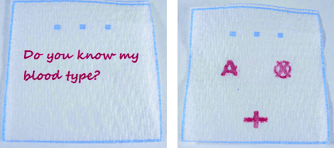Paper-Based Blood Typing Device That Reports Patient’s Blood Type “in Writing”
Li, M.; Tian, J.; Al-Tamimi, M.; Shen, W. Angew. Chem. Int. Ed. 2012 DOI: 10.1002/anie.201201822
Summary: What’s your blood type? Chances are you are O+ or A+, but you could also be one of six other types. Knowing your blood type isn’t purely an exercise with no practical basis – it is a critical detail in medicine when giving a person a blood transfusion. Providing the wrong blood type during transfusion can have fatal consequences. While labs in modern hospitals have no problem determining the blood type of their patients, a clinic in a remote region may not have those resources. Consequently, it is of interest to develop easy to use diagnostic tools capable of rapidly identifying blood type. A potentially simple solution would be a piece of paper infused with the correct reagents patterned such that application of a drop of blood resulted in a colored ‘bar code’ which could be decoded. An example would be those colored pH strips. Unfortunately, even decoding a colored pattern can be tricky – ideally you would write your question ‘What’s my blood type?’ onto the paper and the paper would tell you – much like Riddle’s diary in the Chamber of Secrets (although more ideally without the creepy partial-soul of an evil dark lord inhabiting it*). Some folks in Australia recently tried to do just that!

Key to the author’s work was agglutination, a process in biology which describes the aggregation of smaller particles, i.e. cells. Hemagglutination is a special subset which describes the aggregation of red blood cells upon introduction of the correct antibody. These particular antibodies act sort of like multi-dentate ligands in that they can attach to multi different red blood cells, clumping them together. Test papers were made patterning the right antibodies onto a piece of paper using a pen or ink jet printer loaded with a solution of the correct antibodies. Applying blood to this paper then has two possible outcomes – if the antibody matched the blood type then hemagglutination occurs and the blood would stick to the paper. Alternatively the antibodies would not match the blood type and so the blood would be washed off. By choosing a symbolic system, this simple process can rapidly reveal the identity of the unknown blood type and this holds promise for cheap diagnostics in areas without the correct medical facilities.
*if I just ruined the 2nd Harry Potter book for you then I’m sorry.


